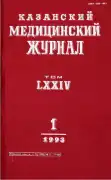Production technology and strength properties of porous permeable materials based on titanium and titanium nickelide for dental implantology
- Authors: Mirgazizov M.Z.1,2, Chobonyan M.A.1,2, Itin V.I.1,2, Gunther V.E.1,2
-
Affiliations:
- Kazan Order of the Red Banner of Labor of the Medical Institute
- Russian Medical Engineering Center for Shape Memory Implants
- Issue: Vol 74, No 1 (1993)
- Pages: 70-72
- Section: Articles
- Submitted: 03.04.2021
- Accepted: 03.04.2021
- Published: 15.02.1993
- URL: https://kazanmedjournal.ru/kazanmedj/article/view/64619
- DOI: https://doi.org/10.17816/kazmj64619
- ID: 64619
Cite item
Abstract
Currently, for dental implantology, structures from porous permeable materials based on titanium and titanium nickelide have been proposed and substantiated. The main advantages of titanium in comparison with other medical materials based on metals and alloys (stainless steel, alloys based on cobalt, chromium, nickel) are high elasticity, sufficient mechanical strength, and increased corrosion resistance in biological media. Porous titanium also retains these qualities. However, titanium, including porous titanium, has some disadvantages: low shear resistance, low wear resistance, and increased fatigue. For porous titanium, these disadvantages are partially leveled after the growth of bone tissue in the pores of the implant and the formation of a composite "porous metal-bone tissue"; nevertheless, they limit the use of titanium.
Keywords
Full Text
About the authors
M. Z. Mirgazizov
Kazan Order of the Red Banner of Labor of the Medical Institute; Russian Medical Engineering Center for Shape Memory Implants
Author for correspondence.
Email: info@eco-vector.com
Russian Federation, Tomsk
M. A. Chobonyan
Kazan Order of the Red Banner of Labor of the Medical Institute; Russian Medical Engineering Center for Shape Memory Implants
Email: info@eco-vector.com
Russian Federation, Tomsk
V. I. Itin
Kazan Order of the Red Banner of Labor of the Medical Institute; Russian Medical Engineering Center for Shape Memory Implants
Email: info@eco-vector.com
Russian Federation, Tomsk
V. E. Gunther
Kazan Order of the Red Banner of Labor of the Medical Institute; Russian Medical Engineering Center for Shape Memory Implants
Email: info@eco-vector.com
Russian Federation, Tomsk
References
- Андриевский Р. А. Введение в порошковую металлургию.— Фрунзе, 1988.
- Анциферов В. Н., Устинов В. С.» Олесов Ю. Г. Спеченные сплавы на основе титана—М„ 1984.
- Гюнтер В. Э., Котенко В. В., Миргазизов М. 3. и др. Сплавы с памятью формы в медицине.—Томск, 1986.
- Гюнтер В. Э., Итин В. И., Монасевич Л. А. и др. Изв.высш.учеб.завед.— Физика,—1989.—№ 1—С.97—100.
- Кипарисов С. С., Либенсон Г. А. Порошковая металлургия.—М., 1961.
- Миргазизов М. 3., Поленичкин В. К., Гюнтер В. Э., Итин В. И. Применение сплавов с эффектом памяти формы в стоматологии,—М., 1991.
- Федорченко И. М., Андриевский Р. А. Основы порошковой металлургии.—Киев, 1961.
Supplementary files







